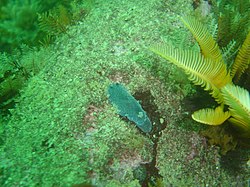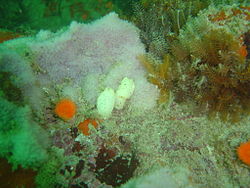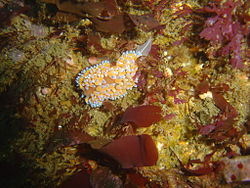At least 20 species of Opisthobranch (sea slugs) have been seen at this site. It is not impossible to see as many as 12 species on a dive, though 6 to 8 is more likely at the Pinnacle dive site.
- Black nudibranch
Tambja capensis is seen in depths usually deeper than 5m, otherwise unpredictable. The adults are usually solitary, but some years ago large numbers of juveniles were seen on blue-green bushy bryozoan colonies, where they were well camouflaged. - Blue-speckled nudibranch
Dendrodoris caesia has been seen on the boulders in the bay at about 7m depth between Sponge Rock and the Pinnacle. - Brown-dotted nudibranch
Cadlina sp2 are fairly frequently seen. Look for them on the fluffy lilac encrusting sponges which are common from about 6m down. - Brush nudibranch
Tritonia sp.2 with egg mass. The olive green soft coral may be eaten by this animal or its offspring. - Cape dorid
Hypselodoris capensis can sometimes be found on the lilac sponge, but also on other substrates - Coral nudibranch
Phyllodesmium horridum is often seen on the red Multicolour sea fans in depths from about 4m to 8m, mostly in the 6m zone. - Crowned Nudibranch
Polycera capensis may be seen at various depths, on a variety of substrates. It is usually solitary and finding them is mostly a matter of luck and keeping a good look out. - Dwarf warty pleurobranch
Pleurobranchaea tarda has been seen on a cerianthid tube in the gravel zone. - Fiery nudibranch
Okenia amoenula is occasionally seen. At times it may be found on yellow scrolled false corals where it lays its eggs. There is a ridge to the south east of the pinnacle where there were large numbers at one time. Depth about 4 to 6m. - Gas-flame Nudibranch
Bonisa nakaza is fairly common, but is usually found in deeper water, generally below 5m. - Ghost nudibranch
Lecithophorus capensis is often seen, frequently on bryozoans, but also on other surfaces. It may be at almost any depth. (not common in winter) - Heather's nudibranch
or Red-spotted nudibranch Chromodoris heatherae is fairly common in the deeper areas to the north east of the pinnacle. It is quite easy to see as it is white with red spots. - Ink spot nudibranch
Ceratosoma ingozi is usually seen below 6m, and seems most common below 8m. It is usually quite common to the north east of the pinnacle. - The Iridescent nudibranch
Notobryon wardi is seen sporadically, mostly in fairly shallow water on red bait pods or encrusting algae of similar brown colour. (not seen in winter) - The Lemon pleurobranch
Berthellina granulata has been seen at night on the boulders just to the south of the pinnacle. - Protea nudibranch
Noumea protea are small and hard to spot, they may be seen on a pink encrusting sponge on the south west and north east face of the pinnacle at about 8m, and on the reefs off the large shore gully to the north. (All year) - Red sponge nudibranch or Orange dorid
Rostanga elandsia may occasionally be seen on orange encrusting sponge of exactly the same colour, making it very difficult to spot. At times it has been quite common. - Scribbled nudibranch
Doriopsilla miniata is occasionally seen. It favours the pale yellow turreted sponge, but is also seen in other places. - The Silver tipped nudibranch
Janolus capensis is usually common and can be found almost anywhere. - Soft coral nuibranch
Tritonia sp has been seen at Sponge Rock and in the gap south of the pinnacle. - Three-spot dorid
Aldisa trimaculata has been recorded at Pinnacle, but is hardly ever seen. - Whip fan nudibranch
Tritonia nilsodhneri has been seen on Flagellar and Sinuous sea fans in the gap south of the pinnacle and to the north east of the pinnacle. - White edged nudibranch
Flabellina capensis has been recorded, but is seldom seen at this site.
Retturn to main article Diving the Cape Peninsula and False Bay/Pinnacle
| This is a gallery page article. It is an auxiliary page for images to reduce bandwidth of Diving the Cape Peninsula and False Bay/Pinnacle. Please plunge forward and improve it if you can! |























